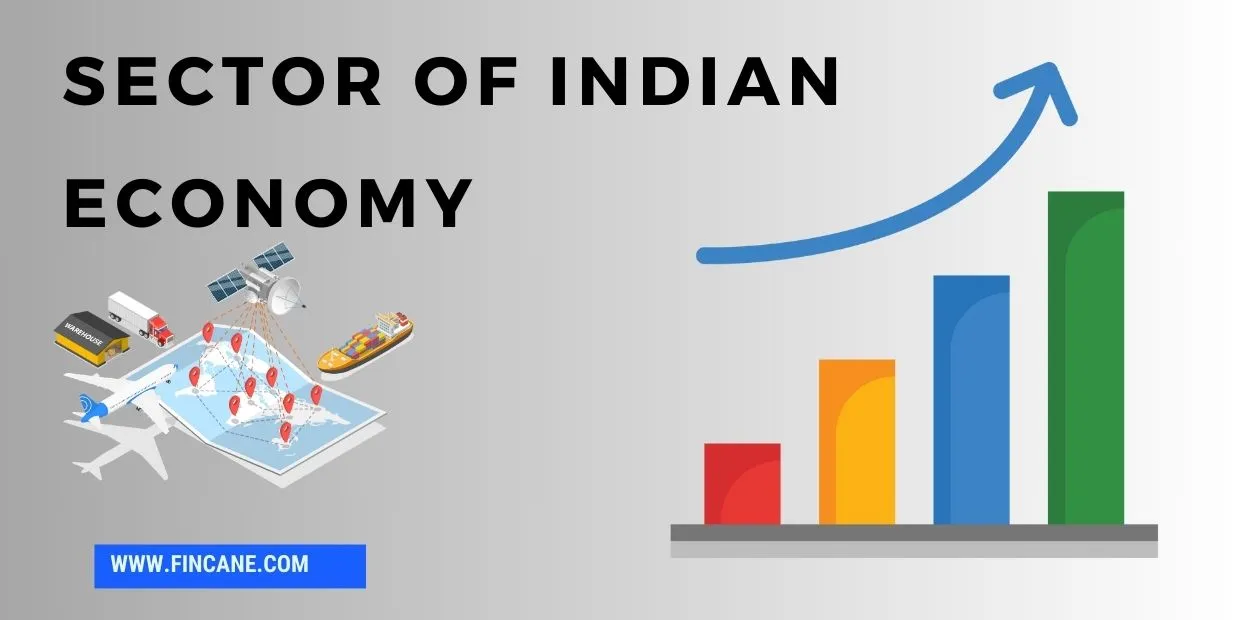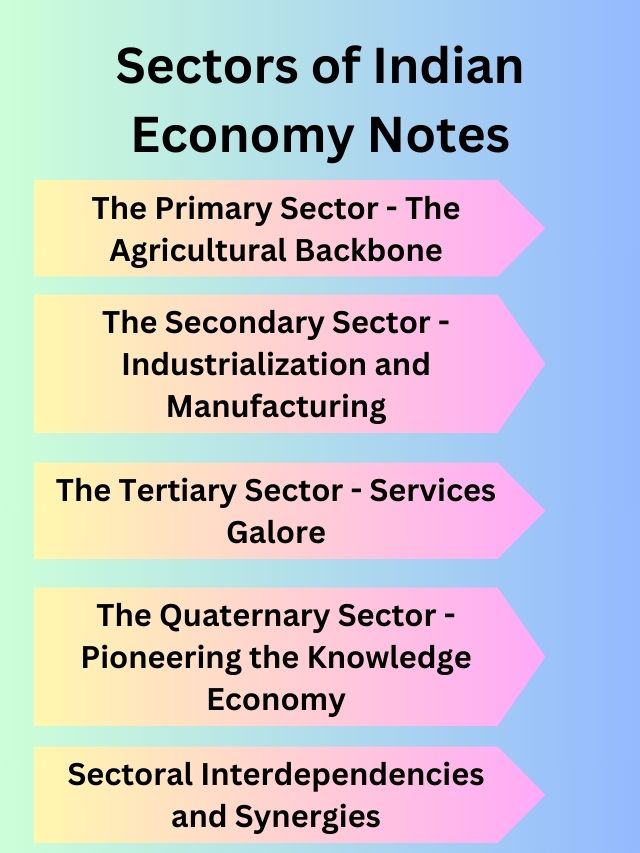Introduction:
In This Article we would cover Sector of Indian Economy Notes India, a land of diversity and resilience, mirrors its economic complexity through a threefold segmentation: the primary, secondary, and tertiary sectors. These sectors encapsulate the heartbeat of the nation’s economic activities, shaping its growth trajectory and providing insight into its development journey.Here are some notes on the sectors of the Indian economy.

Sector of Indian Economy Notes : Five main Sectors:
1-The Primary Sector – The Agricultural Backbone:
The primary sector, comprising agriculture and allied activities, stands as the cornerstone of the Indian economy. In a country where a significant portion of the population is still connected to the land, agriculture plays a pivotal role. Cultivation of crops, animal husbandry, forestry, and fishing collectively contribute to the livelihoods of millions.
Despite the advent of industrialization, agriculture remains a vital component, not just in terms of employment but also in sustaining the nation’s food security. Challenges such as fragmented landholdings, outdated farming practices, and unpredictable weather patterns persist, necessitating comprehensive reforms to modernize and revitalize this sector.
2-The Secondary Sector – Industrialization and Manufacturing:
The secondary sector, often referred to as the industrial sector, encompasses manufacturing, construction, and power generation. India’s journey towards economic self-sufficiency gained momentum with the emphasis on industrialization after gaining independence. Steel plants, textile mills, and manufacturing units dotted the landscape, driving economic growth and providing employment opportunities.
In recent decades, India has witnessed a surge in the establishment of Special Economic Zones (SEZs), promoting exports and foreign direct investment (FDI). The “Make in India” initiative has further bolstered the manufacturing sector, aiming to transform the country into a global manufacturing hub.
However, challenges such as regulatory hurdles, infrastructural bottlenecks, and the need for skilled labor continue to impede the sector’s full potential. Striking a balance between traditional craftsmanship and modern manufacturing practices is essential for sustained growth.
3-The Tertiary Sector – Services Galore:
The tertiary sector, dominated by services, has emerged as a powerhouse in the Indian economy. Banking, insurance, trade, information technology, education, healthcare, and hospitality collectively form the backbone of this dynamic sector. Rapid urbanization and technological advancements have fueled the demand for services, leading to a shift in the employment landscape from agrarian to service-oriented.
India’s prowess in the information technology (IT) sector has earned it global recognition. Cities like Bangalore and Hyderabad are known as IT hubs, contributing significantly to the country’s economic output. The service sector not only provides employment but also positions India as a competitive player in the global market.
However, challenges such as the digital divide, uneven distribution of educational and healthcare facilities, and the informal nature of a substantial part of the service sector workforce underscore the need for inclusive growth and comprehensive policy measures.
4-The Quaternary Sector – Pioneering the Knowledge Economy:
A relatively recent addition to the economic landscape, the quaternary sector focuses on knowledge-based activities such as research and development, innovation, and information services. In the era of the fourth industrial revolution, India is making strides in areas like artificial intelligence, biotechnology, and space exploration.
The establishment of research institutions, technology parks, and incubators reflects a growing commitment to fostering innovation. However, bridging the gap between academia and industry, ensuring intellectual property protection, and cultivating a culture of research and development are critical challenges that demand attention.
5-Sectoral Inter dependencies and Synergies:
The sector of the Indian economy are not isolated entities; instead, they are interconnected and interdependent. A flourishing primary sector, for instance, can fuel demand for goods and services, propelling the secondary and tertiary sectors forward. Simultaneously, a vibrant industrial sector creates employment opportunities, thereby boosting the standard of living and expanding the consumer base.
Efforts to achieve sustainable development must recognize these inter dependencies and seek synergies. Policies that foster a balanced growth across sectors and address the unique challenges faced by each are essential for achieving holistic economic development.
Sector of Indian Economy Notes: Also Know The Father of Indian Economy
PV Narasimha Rao is alluded to as the Dad of Indian Financial matters. From 1991 to 1996, he filled in as India’s 10th Top state leader. Rao, who was brought into the world in the Laknepalli town of Narsampet Mandal in Telangana’s previously Warangal locale in 1921, was a functioning member in the Indian freedom development and an individual from the Indian Public Congress.
The Dad of Indian Financial matters was a lawmaker as well as a legal counselor. The Dad of Indian Financial matters was liable for a significant monetary change in India.
Sector of Indian Economy Notes : Conclusion
India’s economic landscape is a tapestry woven with the threads of agriculture, industry, and services, each contributing to the nation’s resilience and growth. As India navigates the challenges and opportunities presented by a rapidly changing global economic scenario, a harmonious development strategy that encompasses all sectors is imperative.
Striking a balance between modernization and preservation of traditional practices, addressing infrastructural gaps, promoting inclusive growth, and embracing innovation will define India’s journey through its economic sectors.
The dynamism and diversity embedded in these sectors lay the foundation for a robust and vibrant economy, capable of meeting the aspirations of a billion people. In this journey, the sectors of the Indian economy not only shape the nation’s destiny but also contribute to the unfolding narrative of a rising global economic power.

Sectors of Indian Economy Notes: Frequently Asked Questions (FAQ)
Q1: What are the main sectors of the Indian economy?
A1: The main sectors of the Indian economy are the primary sector (agriculture and allied activities), the secondary sector (industrialization and manufacturing), the tertiary sector (services), and the quaternary sector (knowledge-based activities).
Q2: Why is the primary sector considered the agricultural backbone of India?
A2: The primary sector is considered the agricultural backbone of India due to its significant contribution to the country’s economy, employment, and sustenance of a large population.
Q3: How has industrialization shaped the secondary sector in India?
A3: Industrialization has played a crucial role in shaping the secondary sector in India by fostering economic diversification, technological advancement, and the growth of manufacturing industries.
Q4: What initiatives have been taken to boost the manufacturing sector in India?
A4: Initiatives such as the establishment of Special Economic Zones (SEZs) and the “Make in India” initiative aim to promote exports, foreign direct investment (FDI), and transform India into a global manufacturing hub.
Q5: How has the service sector contributed to India’s economic growth?
A5: The service sector has significantly contributed to India’s economic growth by becoming a key driver, generating employment, foreign exchange, and fostering innovation and technological advancements.
Q6: What challenges does the service sector face in India?
A6: The service sector in India faces challenges such as skill gaps, infrastructure constraints, regulatory complexities, and the need for continuous adaptation to global market trends for sustained growth.
Q7: What is the quaternary sector, and how is India pioneering the knowledge economy?
A7: The quaternary sector involves information-based activities. India is pioneering the knowledge economy through its IT and software services, research and development initiatives, and a growing focus on innovation and technology.
Q8: How are the sectors of the Indian economy interconnected?
A8: The sectors of the Indian economy are interconnected as agriculture provides raw materials to manufacturing, which, in turn, supplies goods to the service sector, creating a symbiotic relationship that drives economic growth.
Q9: What does India need to grow and improve in all areas of its economy?
A9: India needs comprehensive policies promoting education, infrastructure, innovation, and inclusive development to achieve holistic economic growth, ensuring progress in agriculture, manufacturing, and services sectors for overall prosperity.
Q10: How does India’s money and business activities make it important in the world?
A10: India’s economic activities and business contribute to its global importance by attracting investments, fostering trade, and showcasing a large market, influencing the world’s economic dynamics positively.
How did you like our post regarding Sector of Indian Economy Notes, Please Tell us the by commenting in the comment box. if you want to ask any question kindly feel free to ask in the comment box. We try give our 100 percent.
Also Read Some Beautiful Article
Fiscal Deficit of India: Why it is in News in 2023 (Effective Guide)
Wrong UPI Transaction : Understanding the Causes, Consequences, and Remedies in 2023-24 {Powerful Guide}
Ladli Laxmi Yojna : Empowerment through Education {2023-24}